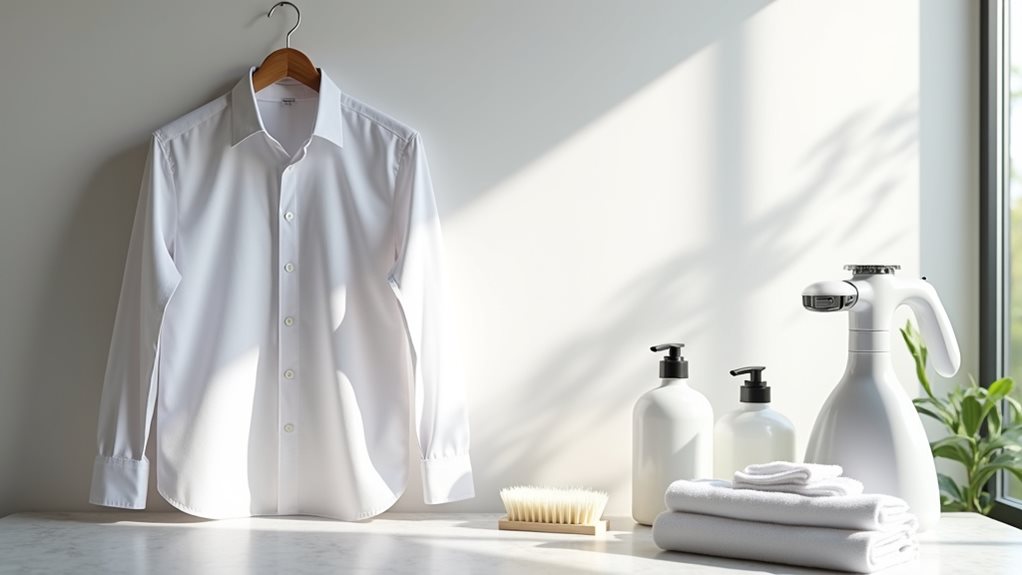You can absolutely dry clean many items at home using specialized kits and gentle techniques, though I’ve learned the hard way that delicate fabrics like silk and wool need extra care. Home dry cleaning works best for lightly soiled garments and spot cleaning, while heavily stained suits or intricate pieces still require professional attention. The key is checking care labels, using mild detergents, and air drying properly to maintain fabric integrity and prevent costly mistakes that’ll teach you more advanced methods.
Understanding When Clothes Need Professional Vs Home Care
When I first moved into my own apartment, I’ll admit I was terribly naive about laundry, throwing everything from my favorite silk blouse to my wool sweaters into the washing machine with reckless abandon 😅.
My college laundry disasters taught me expensive lessons about fabric care the hard way 😬
Learning to distinguish between clothing items that need professional care versus what you can handle at home becomes essential for preserving your wardrobe investment.
Delicate fabrics like silk, wool, and cashmere typically require a professional dry cleaner’s expertise, especially when they’re heavily soiled or have complex construction like suits.
However, home dry cleaning kits work wonderfully for light rejuvenation and spot cleaning between professional visits.
Always check care requirements on labels first—they’re your roadmap to making smart decisions about whether to tackle the job yourself.
Professional dry cleaning uses chemical solvents instead of water to safely remove stains while preserving the fabric’s original structure and preventing the shrinkage or color bleeding that water-based washing can cause.
Essential Supplies and Materials for Home Dry Cleaning
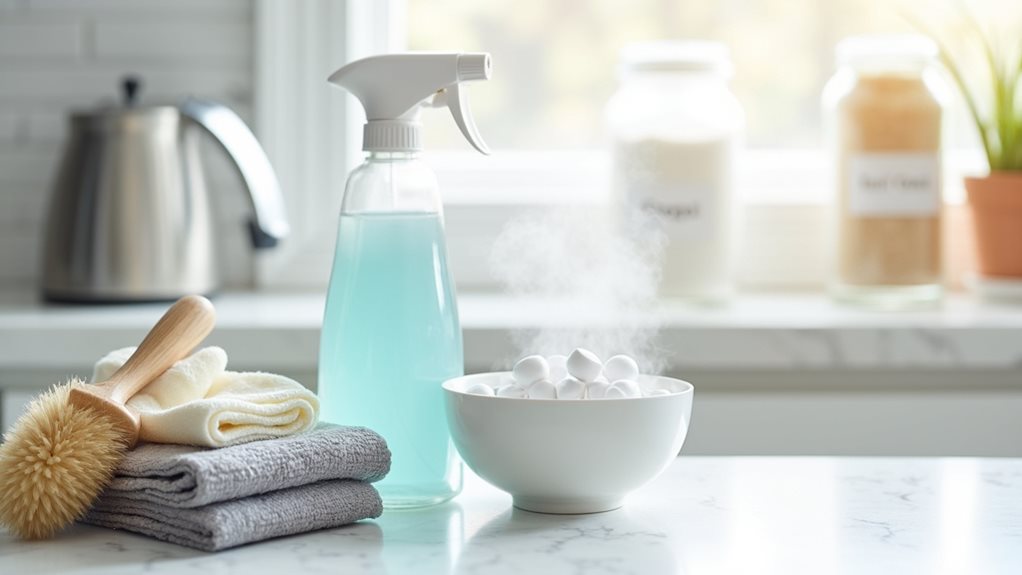
Success in home dry cleaning hinges entirely on having the right arsenal of supplies at your fingertips, and I learned this lesson the hard way after ruining a beloved cashmere cardigan with completely inadequate tools 🤦♀️.
You’ll need home dry cleaning kits like Dryel, which include reusable dryer bags and cleaning cloths that make the process surprisingly manageable. A mild detergent designed for delicate fabrics becomes your gentle guardian angel, protecting precious garments from harsh chemical damage.
Don’t overlook stain remover and a simple white vinegar and water solution for tackling stubborn spots naturally.
Finally, establish your well-ventilated area where proper air circulation prevents moisture buildup, because trust me, soggy “dry cleaned” clothes defeat the entire purpose of this convenient alternative. Keep in mind that these kits work most effectively on lightly soiled items and serve as an excellent maintenance option between professional cleanings.
Step-by-Step Process for Cleaning Delicate Garments
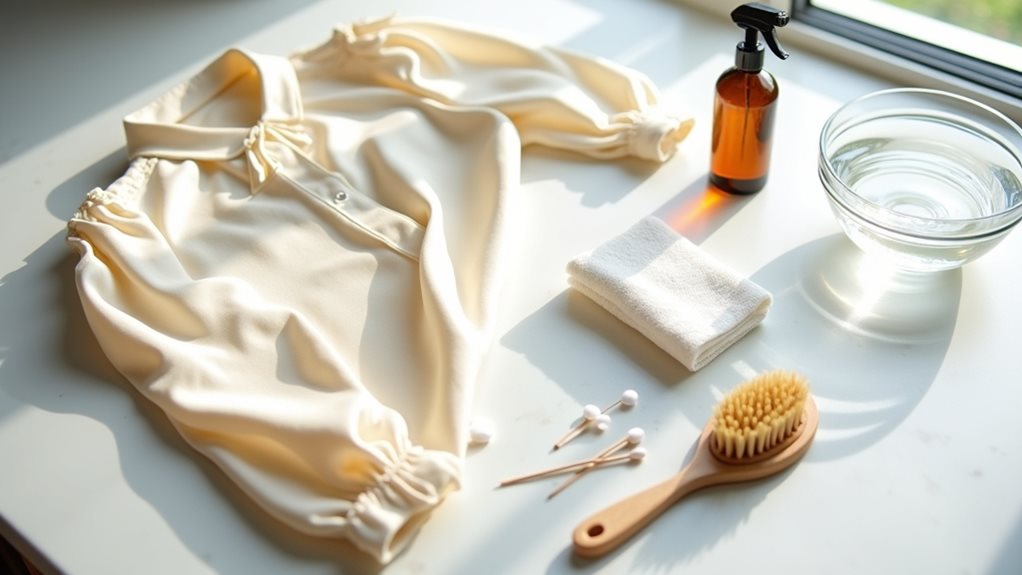
Now that you’ve gathered your supplies, it’s time to walk through the actual cleaning process, which honestly feels a bit like performing surgery on your favorite silk blouse the first time you try it.
You’ll start by preparing your garment and workspace carefully, then apply your cleaning solution with the gentleness of someone handling a sleeping baby, because trust me, I’ve learned the hard way that aggressive scrubbing turns cashmere into felted disappointment.
For home dry cleaning kits, you’ll place the pre-treated garment in the provided bag with a cleaning cloth, seal it, and run it through a dryer cycle where controlled heat activates the cleaning vapors.
Finally, you’ll need to master the art of rinsing and drying properly, since this final step can make or break whether your delicate piece emerges looking refreshed or resembling something you’d find at the bottom of a laundry basket after a college semester 😅.
Prepare Garment and Workspace
Before you dive headfirst into what feels like playing chemist with your favorite silk blouse, take a deep breath and remember that preparation isn’t just about gathering supplies—it’s about setting yourself up for success rather than disaster.
Start by checking your delicate garment’s care label like it’s a treasure map, because trust me, ignoring those tiny symbols is how cashmere sweaters become doll clothes 😅.
Create a clean workspace in a well-ventilated area—your bathroom counter works perfectly if you’ve got good airflow.
Gather your gentle detergent, a basin for cool water, and protective garment bags.
Think of this setup phase as your insurance policy against turning your beloved pieces into expensive cleaning rags, because proper preparation means you’ll actually want to air dry with confidence.
Understanding that delicate materials like silk, wool, and cashmere require specialized cleaning methods will help you approach the process with the care and attention these fabrics deserve.
Apply Cleaning Solution Gently
Treat your delicate garment like you’re diffusing a bomb made of silk threads, because the wrong move here can turn your treasure into a tragic before-and-after story.
When you apply cleaning solution gently to delicate items, you’re channeling your inner surgeon—precise, patient, and completely focused. Dampen your cloth with the cleaning solution, then blot from the outside edges toward the center, because spreading stains is like watching your favorite shirt commit fashion suicide.
Remember, different fabric types demand different approaches, so avoid scrubbing at all costs—think gentle pats, not aggressive wrestling matches.
After treating the spot, rinse thoroughly with cool water to eliminate any residue, then air dry flat to preserve your garment’s original shape and dignity. This gentle approach helps prevent the shrinkage and color bleeding that often occurs when delicate fabrics like wool and silk are exposed to harsh cleaning methods.
Rinse and Dry Properly
After you’ve successfully treated that stubborn stain without turning your favorite blouse into a cautionary tale, the real magic happens during the rinse and dry phase, where one wrong move can undo all your careful work.
First, check that care label religiously—it’s your roadmap to proper washing success. Rinse thoroughly in cool water, gently pressing down to remove excess moisture without wringing like you’re wrestling a wet towel.
For delicate fabrics, roll them in a clean towel for extra absorption. Now comes decision time: hang items prone to wrinkles immediately, or lay flat on towels for ultra-delicate pieces.
Air dry is your best friend here, flipping halfway through for even results. While home care can work wonders for many garments, remember that chemical solvents used in professional dry cleaning are specifically designed to preserve fabric integrity and color retention for your most precious pieces. Trust me, patience during this phase saves tears later!
Effective Stain Removal Techniques for Dry Clean Only Items
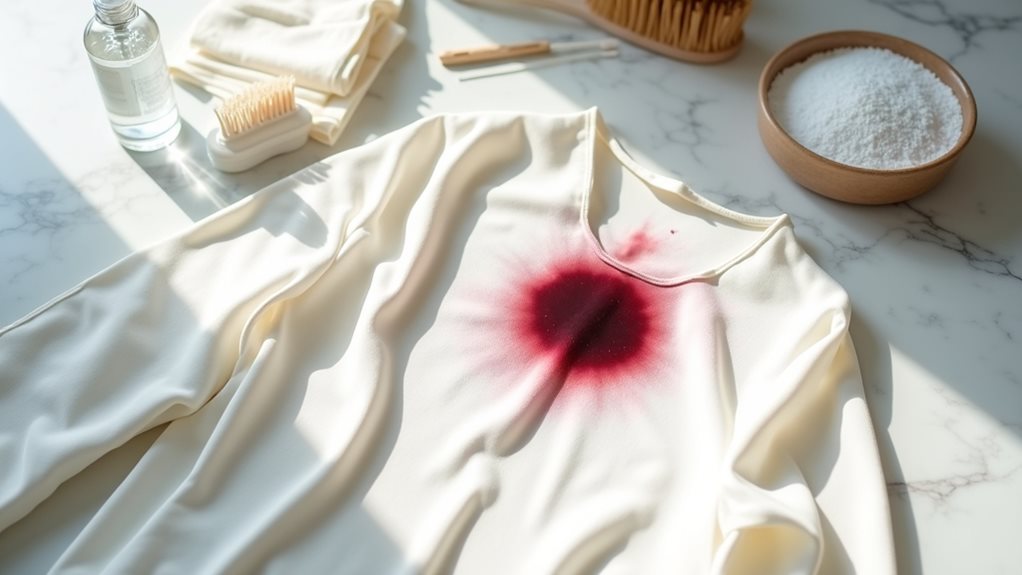
When you’re staring at a fresh stain on your favorite silk blouse—the one that cost more than your grocery budget, trust me, I’ve been there—your first instinct might be panic, but smart spot treatment methods can actually save the day without a trip to the dry cleaner.
You’ll want to master both gentle blotting techniques for water-based mishaps and specialized approaches for those sneaky oil-based disasters that seem to appear out of nowhere, like when I somehow got salad dressing on my cashmere sweater during an important meeting 🤦♀️.
The key lies in understanding which solution works for which type of stain, because treating a grease spot the same way you’d handle a coffee spill is like using a sledgehammer when you need a feather—it just doesn’t end well for anyone involved.
Keep in mind that while home treatments can be effective for fresh stains, chemical solvents used in professional dry cleaning are specifically designed to break down stubborn oil-based and grease stains that water-based home remedies simply can’t tackle.
Spot Treatment Methods
Since my husband once ruined his favorite silk tie by aggressively scrubbing out a coffee stain (lesson learned the hard way! 😅), I’ve become something of a detective when it comes to spot-treating delicate fabrics that typically require professional dry cleaning.
The key to successful spot treatment starts with understanding your enemy – whether you’re dealing with oil-based or water-based stains. Always perform a patch test first on a hidden area to avoid color disasters.
For most stains, I create a gentle vinegar solution using equal parts white vinegar and water, then blot carefully without scrubbing.
When stubborn spots persist, I’ll use a soft-bristle brush with appropriate stain remover, working gently to preserve the fabric’s integrity.
Keep in mind that heat-set stains or very old stains may be permanent regardless of your cleaning method, so immediate treatment always yields the best results.
Oil-Based Stain Solutions
Why do oil-based stains seem to have a personal vendetta against our most beloved garments?
It’s like they know exactly which piece you can’t bear to part with! But don’t panic – you’ve got this. Before you apply stain treatments, always conduct a spot test on a hidden area to verify your fabric won’t react poorly.
Here’s your oil-fighting arsenal:
- Blot with a clean cloth dampened in equal parts white vinegar and water
- Sprinkle baking soda generously over the stain to absorb oil for 15 minutes
- Gently brush away the powder without scrubbing
These methods work together beautifully, and I’ve saved countless “dry clean only” pieces this way. Professional dry cleaning uses chemical solvents specifically designed to dissolve oils and grease that water-based cleaning methods simply cannot tackle effectively.
Safe Methods to Refresh and Deodorize Clothing
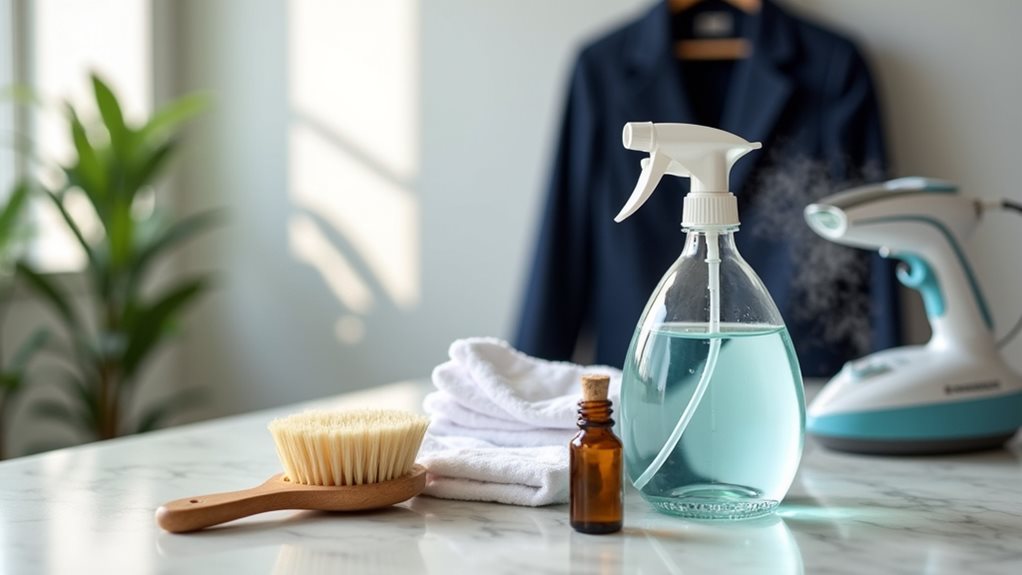
Although professional dry cleaning delivers impeccable results, you don’t always need to make that trip to keep your favorite garments looking fresh and smelling clean.
Steam cleaning works wonders when you toss a damp cloth into your dryer with wrinkled clothes, running it on medium heat for twenty minutes to refresh and deodorize simultaneously. I’ve rescued countless blazers this way, especially after realizing I’d forgotten them in my closet for months 😅.
For spot cleaning delicate fabrics, mix equal parts white vinegar and water to tackle stains without damage.
Add a few drops of vital oil to wool dryer balls for subtle fragrance, or use a natural bristle brush to remove dust from wool and cashmere between professional cleanings.
Dry cleaning kits available at retail stores offer another convenient option for treating garments at home when professional services aren’t accessible.
Proper Drying and Wrinkle Prevention Strategies
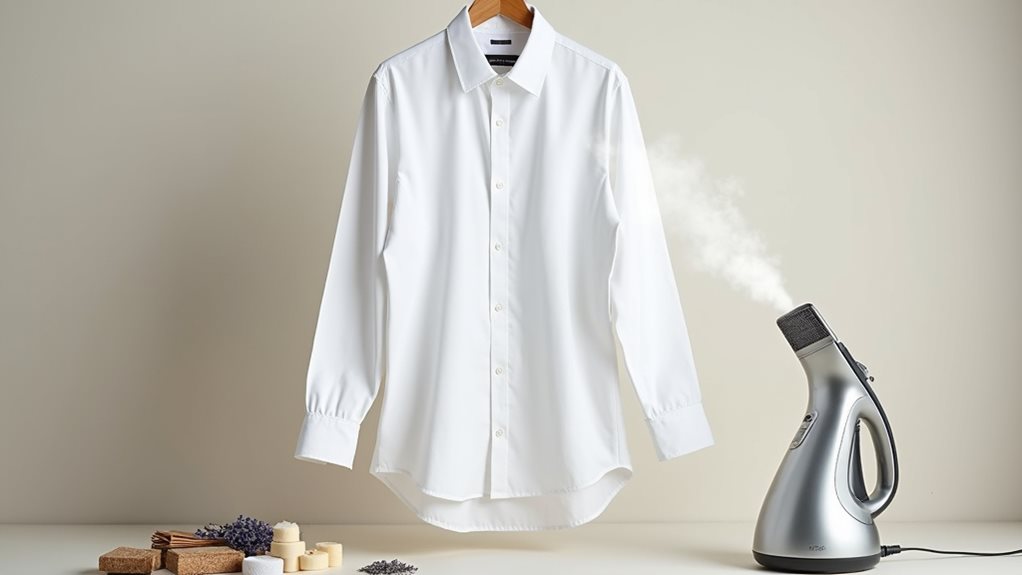
When you’ve invested time and energy into reviving your garments at home, the last thing you want is to undo all that work with improper drying techniques that leave everything looking like you slept in it.
Trust me, I’ve learned this lesson the hard way after spending hours on steam cleaning only to carelessly toss everything into a wrinkled heap.
Here’s your proper drying game plan for wrinkle prevention:
- Hang garments immediately after cleaning, giving them breathing room for air circulation.
- Use padded hangers for delicate materials to maintain shape and prevent shoulder bumps.
- Lay flat on towels for silk or wool items, flipping halfway through drying.
Fabrics You Should Never Attempt to Clean at Home
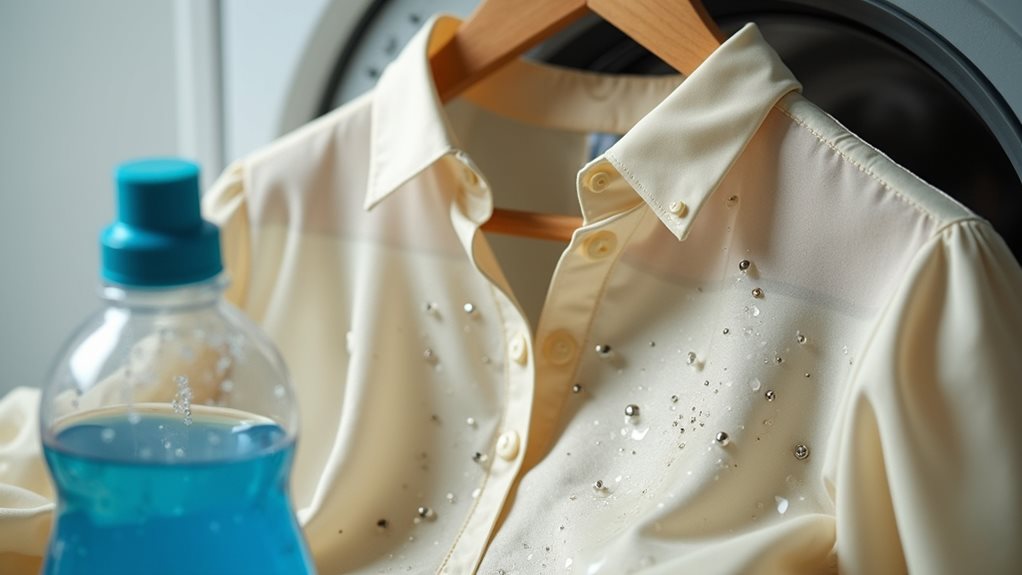
While I’m all for DIY adventures and saving money wherever possible, there comes a point where your home cleaning enthusiasm needs to take a backseat to protecting your investment pieces and sentimental treasures.
You’ll want to keep your hands off fabrics like leather, suede, and velvet – these delicate materials are incredibly sensitive to water and will literally never forgive you for that attempt.
These temperamental fabrics hold grudges like you wouldn’t believe – one water mishap and they’re ruined forever.
Wedding dresses with intricate beading, structured garments like custom suits, and valuable clothing items absolutely require professional care.
I learned this lesson the hard way with a vintage silk blouse that turned into expensive tissue paper 😅.
Trust me, some fabrics need experts who understand their temperamental nature and can dry clean them properly.
Maintaining Garment Quality and Longevity
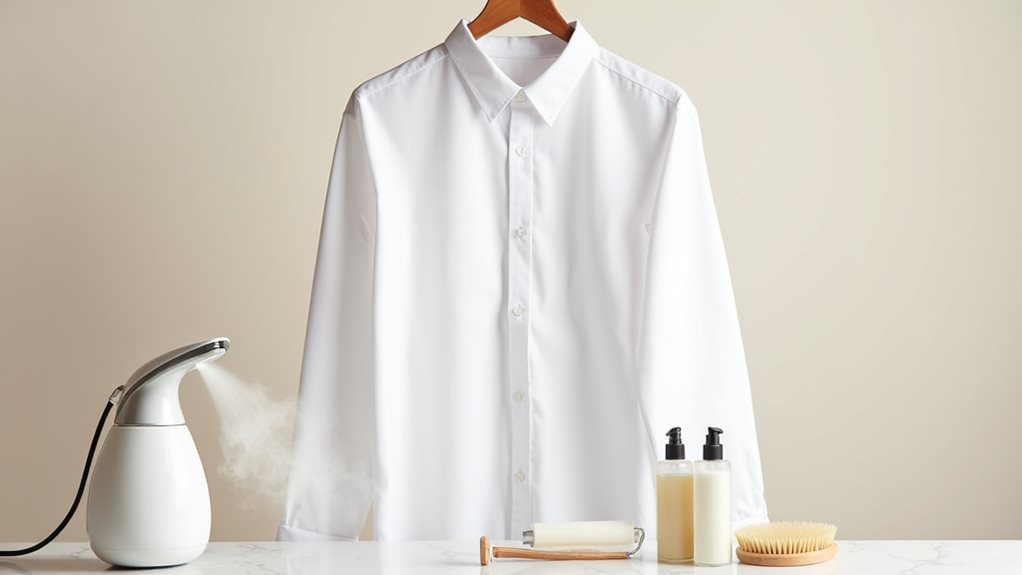
Once you’ve mastered the basics of at-home dry cleaning, the real magic happens in how you approach the long-term care of your wardrobe, because treating each garment like a cherished friend rather than just fabric will transform how long your clothes look and feel incredible.
Here’s my tried-and-true approach to preserving garment quality:
- Read care labels religiously – they’re your roadmap to success
- Sort delicate fabrics by color and weight before every cleaning session
- Rotate between steam cleaning and gentle hand washing to minimize wear
When you wash dry clean items properly using at-home dry cleaning methods, you’ll extend the life of your wardrobe dramatically.
I’ve learned that patience with delicates pays off – my favorite silk blouse still looks new after three years! 🌟

